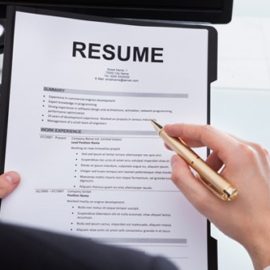Disclosure: I may earn affiliate revenue or commissions if you purchase products from links on my website. The prospect of compensation does not influence what I write about or how my posts are structured. The vast majority of articles on my website do not contain any affiliate links.
Two of the earliest posts that I wrote on this blog were Understanding the Resumé Screener and Beating the Resumé Screener. The point of these articles was to provide counter-arguments to much of the ridiculousness that one can find atop the Google search results for resumé-related topics. These are crowded keywords as far as SEO goes, and even while these two remain among of the most popular posts on my blog, they haven’t reached a particularly wide audience.
There’s another reason that I’ve taken such an interest in resumés. I went to a fairly competitive college and was dumbfounded to find that nearly every resumé I encountered had errors. These weren’t drafts–they were posted on LinkedIn and ready to be sent to employers. I started to offer a service where, for a trivial amount of money, I fixed people’s resumés. As many business ideas go, the hardest part was convincing people that they needed my product. Fresh off having updated my own resume and finding a new job, I figure it’s time to tie off the trilogy with the most important advice of all: how to avoid the resumé screener.
In my previous posts, I highlighted that resumé screening procedures at most companies are imperfect if not outright black holes. Very few companies have efficient screening procedures. On the other end, all candidates want to optimize their chances of getting the jobs they apply for. They employ cunning methods to maximize the chance that a real person reviews their resumés. As those candidates are hired more frequently, people who still do things by the book and drop their resumés electronically end up having less of a chance with each passing recruiting cycle. Today, I’ll share my tips on how to avoid the resumé screener altogether.
This isn’t true for every candidate, but in many industries, LinkedIn is what you’ll use to make most of your career moves. It’s how you can discover and be discovered. You would be shocked how standardized its use has become. I don’t want to compare using LinkedIn to the early days of Facebook, because while using this social network is still a dance where nobody precisely knows what’s right or wrong, the stakes are too high to pretend like its use is as trivial as exchanging pokes on Facebook.
The first way to use LinkedIn to skip over the traditional screening process is to respond to a LinkedIn ad. There’s no guarantee that a real person will ever look at your resumé, but having your profile accompany your application will usually be an advantage.
Many working professionals use LinkedIn more passively. This is how I found my last two opportunities. I kept my profile up-to-date and comprehensively populated and made sure to be active on the site regularly. This way, I was on recruiters’ radars. Did I still have to submit a resumé? Yes. But I’m sure that it was reviewed by humans because I wasn’t asked to send it until the recruiters contacted me. Some cast a very wide net; it’s a numbers game. However, it is usually clear whether a recruiter has actually vetted you using your profile.
There is a more direct way to get a job using LinkedIn and it’s to directly message your connections or send InMail to people who may be able to expedite your application or connect you with relevant opportunities. The downside to this is that you have to put yourself out there and very directly face the possibility of rejection. Further, people talk. If you’re really bad at making first impressions, or conversely, if you send a bunch of sincere-sounding-yet-identical messages to people who all work at the same company, that’s going to hurt you.
My friends and I have all received messages–from recruiters as well as people who want to network–that are tone-deaf, awkward, and sometimes inappropriate. We remember these messages. While I highly recommend expanding your network on LinkedIn in a way that you are comfortable with, be advised that making mistakes can come back to haunt you.
Referral
The most straightforward way to advance past the first stage of an interview process is the referral. This means that someone in a trusted position in the company is willing to vouch for you. Ideally, it’s someone you’ve worked with in the past. In less ethical situations, it might be a friend of your father’s. It might even be your father.
You don’t necessarily have to be best friends with someone to ask for a referral, but this (and all methods discussed in this article) require relationship building and adept people skills. Being able to score a referral is a privilege and not in any way a right. Many firms encourage weak referrals by offering absurd referral bonuses, but, at the end of the day, nobody is going to want to risk their reputation for someone that they don’t know or don’t at least partially believe in.
The Cold Email
Sending an email to someone who you don’t know and might have little in common with is a tough game. The success rate will be low and it will crush your ego. It’s anxiety-inducing, too. When is it appropriate to follow-up and when should you just move on? In some cases (banking, if you don’t attend a target school), it’s the only shot you have at getting someone to look at your resumé.
The first step of sending a cold email is finding an email address. If you’ve received a business card and have a person’s email address, then, good for you, the email won’t be so cold after all. Maybe a bit tepid. In most cases, though, you’ll want to send a cold email after you’ve identified someone on LinkedIn or a company website (for smaller firms) who you legitimately want to talk to. There are guides on forums like WallStreetOasis on how to figure out someone’s email address based on company naming conventions.
You might not care to network about the person and just want to improve your chances of being considered for a job. Thankfully, when people who are at later stages of their career than you are contacted, they’ll recognize that you are probably looking for career assistance. You usually won’t have to be so blunt, and simply being nice and making an effort to find some common ground will be greatly appreciated. That being said, they have no obligation to help you.
When it comes to writing the email, it has to be short, sweet, yet specific. If it seems like a form email, nobody is going to respond. If you’re drastically underqualified, use incorrect grammar, or make ridiculous claims–you’re better off just not sending one. There is no standard approach here and it’s best to review with friends, professors, or colleagues if you are planning on making a concerted effort doing this.
Career Fairs
Congratulations. If a company is recruiting at your school, you have a significantly better chance of getting an interview than the typical candidate who will have to rely on the steps above. An on-campus recruiting presence communicates an employer’s interest in students from your school and sometimes means that they will reserve a select few spots just for your classmates. The phenomenon of on-campus recruiting really only gets attention in banking circles, and I’ve written a blog post about it to help get the word out.
After you make it to the career fair and walk up to the booth, the most important thing for you to do is to send a follow-up email to whoever you met. In some cases, you might run into a young alumnus who you might have a connection with and will be able to refer you. In any case, the recruiter will be empowered to expedite your path through the process and it’s imperative that you make that connection as soon as possible.
This wraps up my writings on resumés for now. Thanks for reading and best of luck with whatever opportunities you are pursuing. Please don’t hesitate to contact me with any questions about my personal experiences.




